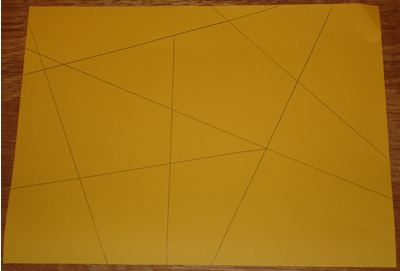Skip over navigation
For this activity, you'll need:
Using your pencil and ruler, draw some straight lines on your piece of paper to make an interesting pattern. You can draw as many or as few as you like. This is what I drew:

Can you describe what you see in your own pattern?
Can you find any shapes which have three sides?
How about any with four sides?
Which shape or shapes have the most sides?
Using your coloured pencils or pens, decorate all the three-sided shapes in some way. You could colour them all in using a particular colour or you could cover them with a special design or pattern.
Can you decorate all the four-sided shapes in another, different, way?
How about the five-sided/six-sided ... shapes?

Or search by topic
Number and algebra
Geometry and measure
Probability and statistics
Working mathematically
Advanced mathematics
For younger learners
Shapely Lines
Age 5 to 7
Challenge Level 





For this activity, you'll need:
- a piece of paper
- a pencil
- a ruler
- some coloured pencils or pens
Using your pencil and ruler, draw some straight lines on your piece of paper to make an interesting pattern. You can draw as many or as few as you like. This is what I drew:

Can you describe what you see in your own pattern?
Can you find any shapes which have three sides?
How about any with four sides?
Which shape or shapes have the most sides?
Using your coloured pencils or pens, decorate all the three-sided shapes in some way. You could colour them all in using a particular colour or you could cover them with a special design or pattern.
Can you decorate all the four-sided shapes in another, different, way?
How about the five-sided/six-sided ... shapes?
This activity is based on an idea in Mathematics Through Art and Design published by Collins Educational.
You may also like
Let's Investigate Triangles
Vincent and Tara are making triangles with the class construction set. They have a pile of strips of different lengths. How many different triangles can they make?

